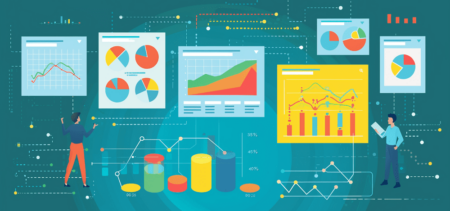Browse. Click. Checkout. The process of shopping has been remarkably simplified over the last decade or so, thanks to ecommerce and online shopping. From groceries and clothing, to appliances and furniture, everything is simply a click away. In the world of ecommerce, convenience is the ultimate sophistication, and the service providers who deliver a seamless experience are rewarded with the unwavering trust and loyalty of their customers. The catch? Delivering on customer experience means juggling a dozen balls in the air, with even the slightest lapse in focus wreaking havoc. Site maintenance, accurate stock updates, plugins with the right payment gateways, delivery, and communication are all essential aspects of the online shopping experience; the old adage applies, prevention is better than cure.
Adding AI to Ecommerce Fulfillment
One of the benefits of the rapidly expanding use cases of artificial intelligence is in shipping and logistics. Supply chain management used to be the domain of large companies and brands, and even when online shopping first burst onto the scene, it was difficult to conceive that delivery companies would be a regular feature in our homes. With this revolution has come institutional change. Adding technology to supply chain and logistics was inevitable, but with personalized online shopping and deliveries, it’s become a necessary feature for logistics and supply chain companies.
With a myriad of companies to choose from, some of the standout features in shipping are the adoption of cloud computing, IoT, and AI. These tools allow for greater visibility and real-time tracking, which means increased transparency for customers. In 2024, we expect machine learning, AI, and blockchain technology to feature heavily in new iterations of supply chain software to increase visibility, agility, and safety while reducing costs.
Expect Constant Innovation in Last Mile Delivery
Nothing has elevated the online shopping experience quite like same-day delivery. Forgot a key ingredient for a special dinner? No problem, order it while at work and find it waiting for you by the time you get home. No time to grab a gift before the party? Same-day delivery is here to save the day. Receiving your purchase a few hours after buying, isn’t just a tool for convenience; it’s a powerful psychological tool linked to instant gratification. Experts suggest that closer collaboration between businesses and logistics companies is expected as they work together to iron out the kinks and resolve customer complaints within last-mile delivery. Strategies to bolster service include crowd-shipping, delivery lockers, and transport hubs, with technology playing a key role in keeping customers and businesses abreast of delivery timeframes.
Introducing Omnichannel Fulfillment
In keeping with the importance of last-mile delivery for customer satisfaction, order fulfillment has seen changes over the last few years. Covid was the catalyst for the complete overhaul and transformation of fulfillment processes. With so many moving parts in terms of restrictions, differences in international response and policy, and limited access to traditional shopping, the ecommerce industry had to adapt quickly. More customers, fewer resources, and challenges across the board meant silos weren’t going to work. Omnichannel fulfillment rose to the occasion, breaking down barriers between customers, stores, delivery companies, and warehouses. This strategy has prevailed even in our post-pandemic landscape because ecommerce is no longer a one-directional flow (warehouse-store-end customer). Customers need to facilitate returns and exchange of goods, which requires flexibility and communication between different parties.
Ecommerce Gets Social
Social commerce has emerged in recent years as an off-shoot of ecommerce, driven by the power of social media to influence purchase decisions. Hashtags that drive purchases like #TikTokMadeMeBuyIt have lent the gift of going viral to products, resulting in sold-out purchases on platforms like Amazon—for everything from leggings to shapewear. Using social media as a marketing strategy allows brands to engage with their customer base directly. While influencers are still largely responsible for driving traffic to ecommerce sites, there’s an uptick in user-generated content as people are looking for authentic customer experiences and reviews. From an ecommerce perspective, this deepens the relationship between customers and brands while increasing sales conversions. As technology gets smarter at integrating different tools and platforms, the increase in social media will be driven by online retailers who are looking for more than just an opportunity to build brand awareness; they’ll be mining for data! The consumer behavior across different platforms, the engagements, the affiliate links, and click-throughs all paint a picture for retailers, who can start to use AI to create more personalized journeys and experiences for consumers, based on individual needs.
Ecommerce Gets Personal
Experts have long theorized that the future of data-driven insights would lead to hyper-personalized online shopping. In fact, a 2018 report by Accenture indicated that 91% of consumers preferred to shop with brands that paid attention to their preferences. Skipping ahead to 2024, thanks to artificial intelligence, we can expect personalization to become the norm in online retail. A traditional shopping experience involves assistance from salespeople, relationships are formed, and customers are able to get a “feel” of the brand the moment they enter a brick and mortar establishment. Online retailers can’t directly compete with that, but what they can do, is perfectly curate a shopping experience based on your clicks, likes, saves, and purchases. And honestly, it’s a pretty close second! Hyper-personalization uses the power of AI and algorithms to create a unique retail experience for every customer. Personalization processes can also be used for inventory management systems to prevent stockpiling and reduce excess waste, which is great for sustainability, and leads us to our next trend to watch in 2024.
Sustainability as a Core Consideration
Online shopping contributes 37% of global greenhouse gas emissions. Consumers might love the convenience of online shopping, but they’re still conscious of the environmental impact of ecommerce. Consumers are increasingly more aware of “greenwashing” and want to see real, tangible impact based on company policies and practices. In terms of online shopping, customers concerned with sustainability will prioritize eco-friendly platforms and brands, and are willing to pay more for this. The push for sustainability will likely grow as Gen Z’s purchasing power increases, and they enter the consumer market. Some industries are beleaguered by unsustainable processes and will have a more challenging time convincing consumers of their environmental friendliness (fast fashion, we’re looking at you). For brands operating in other industries, consumers are urging them to implement end-to-end sustainable policies, ensuring a gentle process from manufacturing all the way to waste management.
Conclusion
2024 is an exciting year for online retail and ecommerce. With the promising integration of AI and machine learning, we expect to see new ways of doing business; ecommerce will be more agile, transparent, collaborative, and personal. The goal is to constantly improve the customer experience, and with AI able to process data and derive insights, brands have a real opportunity to hyper-personalize the online journey and offer consumers a highly curated digital retail experience. Social media adds new elements to the industry as well, allowing smaller brands to cut through the noise by deepening relationships with their customers through user-generated content and data analytics. Lastly, climate-consciousness trumps convenience; consumers want to see real change in the industry’s response to sustainability, and they’re willing to use their dollars to back it up. Sustainability measures will feature more prominently where possible, and for those who can’t adapt, an interesting landscape lies ahead! All in all, it looks like 2024 is the year of innovation, personalization, and environmental conservation, with AI at the intersection of all these points.





























